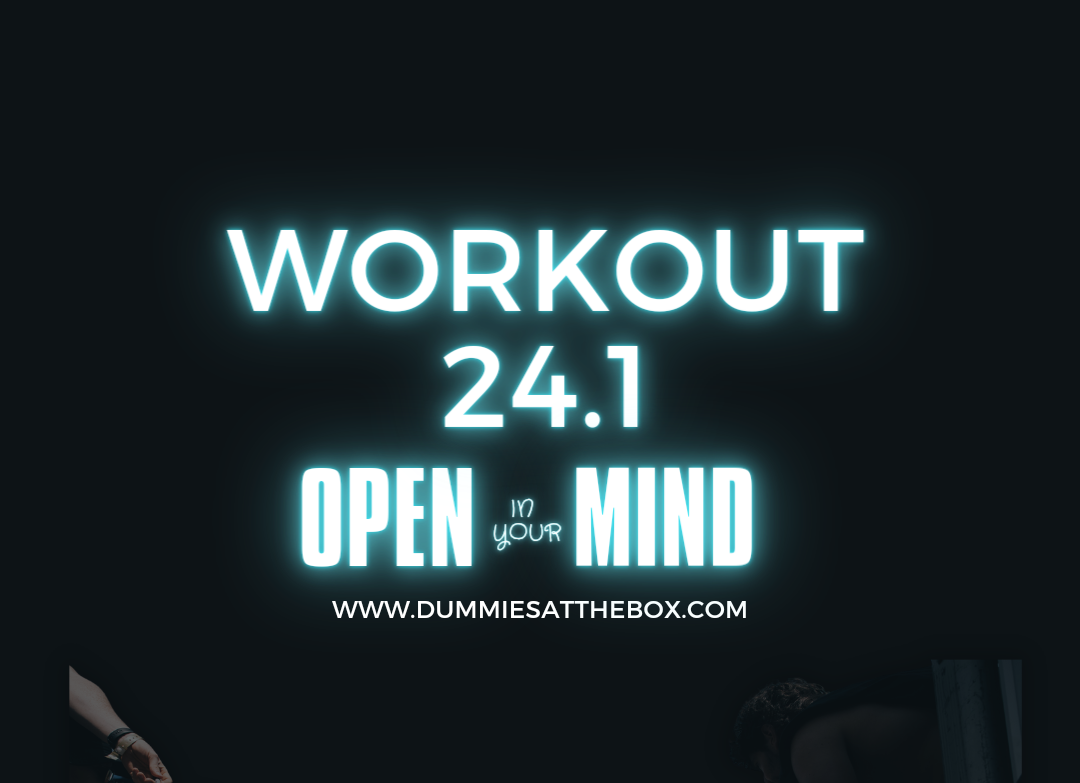Open workout 24.1 is out! Let’s start with this guide for your right mindest
No matter how many strategy and tip videos you’ve watched, they all share the same underlying message: “This is going to suck!”.
Let’s face it, a burpees workout isn’t exactly a walk in the park, especially for your brain – it doesn’t respond well to oxygen deprivation. Probably, at some point in the round of 21, your brain might start screaming at you: “Slow down!” “Stop!” “I can’t breathe!”. And that’s perfectly normal. Your brain does that to keep you safe, but we know that by this point there is MUCH more in the tank than your mind is willing to admit.
During a workout like this, your body’s demand for oxygen increases as you exert yourself. As you start the workout, your heart rate and breathing rate will rise to supply more oxygen. This increased oxygenation helps fuel your brain and muscles, allowing them to function optimally to coordinate movements, regulate body systems, and process information.
However, as the intensity of the workout continues, your body may struggle to keep up with the oxygen demand. This can lead to a temporary decrease in oxygenation in your brain. As a result, you may experience symptoms like dizziness, light-headedness, or a feeling of mental fog as your brain is working with less oxygen than it ideally needs.
That is the moment when your mind is going to start screaming at you to slow down.
To mitigate this, you can do a few things:
- Focused breathing. Deep, controlled breathing ensures a steady supply of oxygen, helping to sustain mental clarity and focus throughout the workout.
- Get into the WOD with a plan. Only top athletes can afford to push to 100% all the way through. For everyone else, it will be necessary to choose a strategy to maintain the pace. Start with a plan in mind, with rough estimates of the timings/ sets/ rhythm that you think will work for you, and adjust based on how you feel. Remember that where you decide to push hard, you must push hard!
- Be sure to stick to YOUR plan. We all know the feeling when you see with the corner of your eyes the athletes next to you and you want to chase them. DO NOT do it in this WOD. Not because for most of us “the Open are a challenge only against yourself”, but because if you start going to a pace that is not yours… this won’t end well.
- Stay in the present moment. If you have practiced mindfulness before, it will be a lifesaver in this wod. If you haven’t, try to pay attention to your breath, movements, and sensations. Being mindful helps you not to get dragged away by your brain screaming at you to slow down, and it will help you to keep a faster, constant, pace.
- Mantra. If you are struggling to get out of your head and be in the moment, try repeating a motivating phrase to yourself, such as “Just a few more reps”, “I have got this” or “Stop with the bullshit, brain”. This acts as a mental anchor, helping you combat your overprotective mind and maintain mental clarity despite physical exertion.
As you progress through the workout, your body will adapt to the increased demand for oxygen by improving its efficiency in oxygen utilization. This adaptation will enhance your cardiovascular and respiratory systems’ ability to deliver oxygen-rich blood to your brain and body, and everything will feel much easier! If you managed well the round of 21, when you get to the round of 15 the hardest part is done… Time to change gear at the round of 9!
After the WOD, take a minute (or 10) to breathe, enjoy your endorphins and community, and refill your tank (our fuel of choice would be pizza… or two!). Given that the Open wods are tests, take a moment to reflect afterwards. You want to make the most out of the experience, learn something from it, identify your weaknesses and develop a strategy to make your future training more purposeful. Prompts for reflections could be: “Was your plan okay? If not, why? Were you able to stick to it? If not, why? Did having people around you get in the way of sticking to your plan? Were you overthinking? Did you have unrealistic expectations for yourself? Did you particularly struggle with a movement/ the weight/ your engine? Are you proud of your result? What do you need to change to address any problems that emerge? What support do you need to work on that? Who is the best person to help you with that?”
To sum up
Before the WOD:
- Dive into technical tips and insights from top-notch coaches.
- Craft YOUR strategy tailored to YOUR abilities.
- Start with a solid warm-up to prep both mind and body.
During the WOD:
- Stay locked in with focused breathing.
- Stick to YOUR game plan, no matter what is going on around you.
- Get out of your head – stay present!
- Use mantras to deal with the overprotective voice in your mind.
- Foremost, have fun!!!
After the WOD:
- Breathe!
- Community & Food.
- Reflections/ Takeaways/ Plan.
ITALIAN VERSION – La guida mentale per il 24.1 degli Open
Indipendentemente da quanti video di strategie e consigli tu abbia guardato, tutti hanno lo stesso messaggio sottostante:
“Sarà dura!”.
Ammettiamolo, un wod a base di burpees non è esattamente una passeggiata di salute, soprattutto per il tuo cervello, che non reagisce bene alla privazione di ossigeno. Probabilmente, a qualche punto nel round dei 21, la tua mente comincerà ad urlarti: “Rallenta!” “Fermati!” “Non riesco a respirare!”. Ed è perfettamente normale. Il tuo cervello fa così per proteggerti, ma sappiamo che a questo punto c’è MOLTO di più nel serbatoio di quanto la tua mente sia disposta ad ammettere.
Durante un wod come questo, la richiesta di ossigeno del tuo corpo aumenta man mano che ti sforzi. Quando inizi il wod, la tua frequenza cardiaca e il tuo ritmo respiratorio aumenteranno per fornire più ossigeno. Questa maggiore ossigenazione aiuta ad alimentare il tuo cervello ed i tuoi muscoli, consentendo loro di funzionare al meglio per coordinare i movimenti, regolare i sistemi corporei ed elaborare le informazioni.
Tuttavia, man mano che l’intensità del wod continua, il tuo corpo potrebbe avere difficoltà a tenere il passo con la richiesta di ossigeno. Questo può portare a una temporanea diminuzione dell’ossigenazione al tuo cervello. Di conseguenza, potresti sperimentare sintomi come vertigini o una sensazione di confusione mentale, visto che il tuo cervello sta lavorano con meno ossigeno di quanto ideale. In quel momento, la tua mente inizierà ad urlarti di rallentare.
Per mitigare questo, ci sono alcune cose che puoi fare:
- Respirazione intenzionale. Respira profondamente e controllatamente per garantire un flusso costante di ossigeno, per mantenere chiarezza mentale e concentrazione durante il wod.
- Entra nel wod con un piano. Solo i migliori atleti possono permettersi di spingere al 100% dall’inizio alla fine. Per tutti gli altri, sarà necessario scegliere una strategia per mantenere il ritmo. Inizia con un piano in mente, con stime approssimative dei tempi/ sets/ ritmi che pensi funzioneranno per te, ed adatta in base a come ti senti. Ricorda che dove decidi di spingere forte, devi spingere forte!
- Assicurati di seguire IL TUO piano. Tutti conosciamo la sensazione di quando con l’angolo dell’occhio vedi gli atleti accanto a te e vuoi inseguirli. NON farlo in questo wod. Non perché per la maggior parte di noi “gli Open sono una sfida solo contro noi stessi”, ma perché se inizi a tenere un ritmo che non è il tuo… non finirà bene.
- Resta nel momento presente. Se hai praticato la mindfulness prima, sarà una manna dal cielo in questo wod. Se non l’hai mai fatto, cerca di prestare attenzione al tuo respiro, ai tuoi movimenti ed a ciò che senti nel corpo. Essere focalizzato nel momento presente ti aiuta a non farti trascinare dal tuo cervello che ti urla di rallentare, e a mantenere un ritmo più veloce e costante.
- Mantra. Se stai facendo fatica a non pensare e restare nel presente, prova a ripeterti una frase motivante, come “Solo qualche ripetizione in piú”, “Ce la posso fare” o “Basta con le cazzate, cervello!”. Questo servirà da ancoraggio mentale, per combattere la parte iperprotettiva della tua mente e mantenere un po’ di chiarezza mentale nonostante lo sforzo fisico.
Man mano che procedi con il wod, il tuo corpo si adatterà alla crescente richiesta di ossigeno e sarà più efficiente nel suo utilizzo. Questo adattamento migliorerà la capacità del tuo sistema cardiovascolare e respiratorio di fornire sangue ricco di ossigeno al tuo cervello ed al tuo corpo, e tutto sembrerà molto più facile! Se hai gestito bene il round dei 21, quando arrivi al round dei 15 la parte piú difficile è andata… È ora di cambiare marcia nel round dei 9!
Dopo il WOD, prenditi un minuto (o 10) per respirare, goderti le endorfine e la tua community, ed assicurati di ricaricare il serbatoio (la nostra scelta di carburante sarebbe una pizza… o due!). Dato che questi wod sono un test, prenditi un momento per riflettere ed imparare il più possibile dall’esperienza. Identifica i tuoi punti deboli e sviluppa un piano d’azione per rendere i tuoi allenamenti futuri più mirati. Suggerimenti per le riflessioni potrebbero essere: “Il tuo piano era ok? Se no, perché? Sei riuscito a mantenerlo? Se no, perché? Avere intorno delle persone ti ha impedito di seguire il tuo piano? Stavi pensando troppo? Avevi aspettative irrealistiche su te stesso? Hai avuto particolari difficoltà con i movimenti/ il peso/ la tua resistenza? Sei orgoglioso del tuo risultato? Cosa devi cambiare per affrontare eventuali problemi emersi? Di che tipo di supporto hai bisogno per lavorarci su? Chi è la persona migliore per aiutarti in questo?”
Per riassumere,
Prima del wod:
- Raccogli consigli tecnici e strategici dai coach più esperti.
- Sviluppa LA TUA strategia adattata alle TUE capacità.
- Fai un buon warm-up e prepara mente che corpo a quello che sta per succedere.
Durante il WOD:
- Respirazione intenzionale.
- Segui il TUO piano, non prestare attenzione a ciò che accade intorno a te.
- Resta presente – focalizzati su respiro/ movimenti/ sensazioni.
- Usa mantra per gestire la vocina nel tuo cervello.
- Soprattutto, divertiti!!!
Dopo il WOD:
- Respira!
- Community & Cibo.
- Riflessioni/Lezioni apprese/ Piano d’azione.

